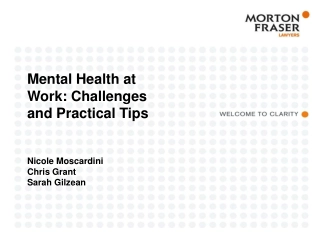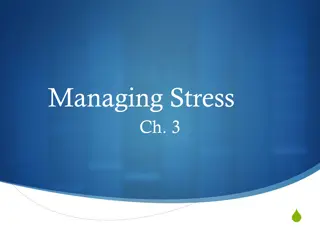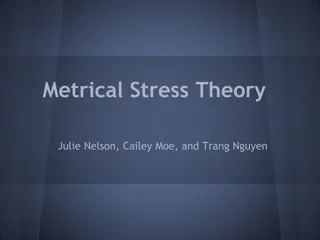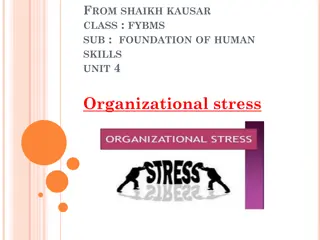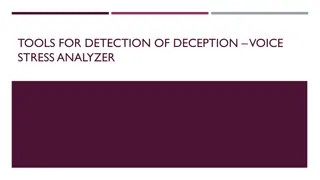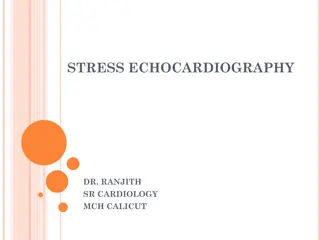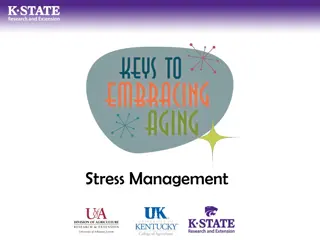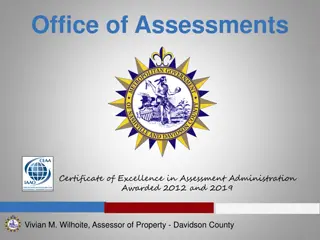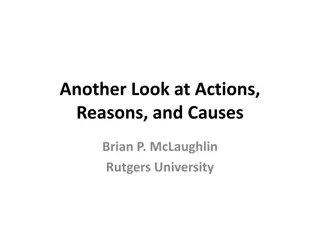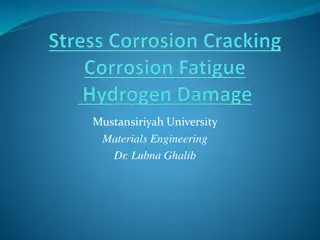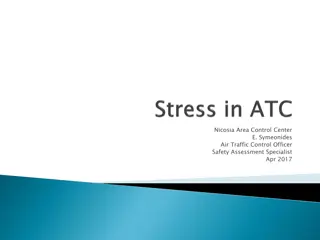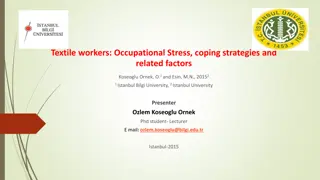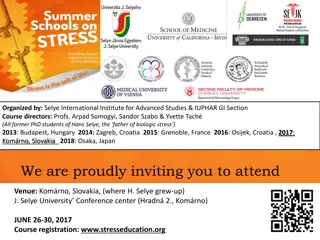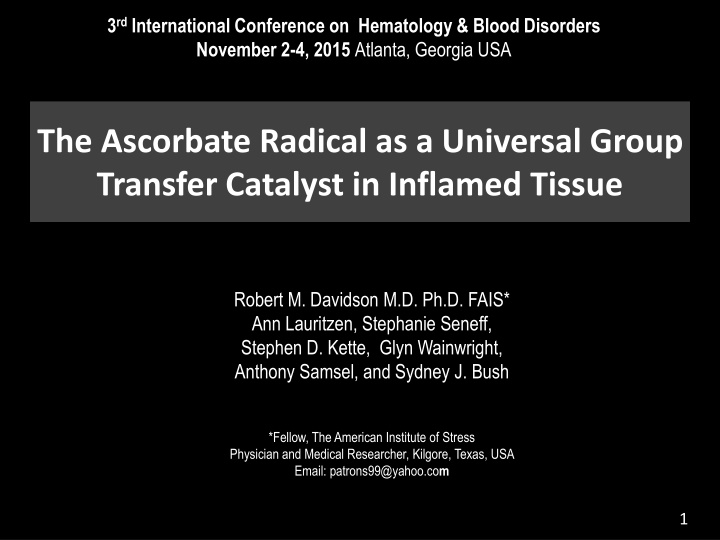
Key Insights Into Ascorbate Radical as Group Transfer Catalyst in Inflamed Tissues
Explore the role of the ascorbate radical as a universal group transfer catalyst in inflamed tissues presented at the 3rd International Conference on Hematology & Blood Disorders. This hypothesis delves into various group transfer mechanisms such as sulfuryl, phosphoryl, nitrosyl, acyl, and glycosyl transfers. The discussion includes the definition of catalyst, catalysis, autocatalysis, and solvent effects, particularly focusing on Marcus On-Water Heterogeneous Phase Catalysis. Discover the significance of exogenous interfacial water stress in inflammation and disease through the initial common pathway.
Download Presentation

Please find below an Image/Link to download the presentation.
The content on the website is provided AS IS for your information and personal use only. It may not be sold, licensed, or shared on other websites without obtaining consent from the author. If you encounter any issues during the download, it is possible that the publisher has removed the file from their server.
You are allowed to download the files provided on this website for personal or commercial use, subject to the condition that they are used lawfully. All files are the property of their respective owners.
The content on the website is provided AS IS for your information and personal use only. It may not be sold, licensed, or shared on other websites without obtaining consent from the author.
E N D
Presentation Transcript
3rd International Conference on Hematology & Blood Disorders November 2-4, 2015 Atlanta, Georgia USA The Ascorbate Radical as a Universal Group Transfer Catalyst in Inflamed Tissue Robert M. Davidson M.D. Ph.D. FAIS* Ann Lauritzen, Stephanie Seneff, Stephen D. Kette, Glyn Wainwright, Anthony Samsel, and Sydney J. Bush *Fellow, The American Institute of Stress Physician and Medical Researcher, Kilgore, Texas, USA Email: patrons99@yahoo.com 1
OVERVIEW: Central Hypothesis The Ascorbate radical is a Biological Group Transfer Catalyst in Inflamed Tissue Sulfuryl group transfer (transsulfurylation) Phosphoryl group transfer (transphosphorylation) Nitrosyl group transfer (transnitrosylation) Acyl group transfer (transacylation) Glycosyl group transfer (transglycosylation) 2
CONCEPTUAL OVERVIEW: Sulfuryl group transfer Phosphoryl group transfer Nitrosyl group transfer Acyl group transfer Glycosyl group transfer 3
DEFINITION: CATALYST / CATALYSIS / AUTOCATALYSIS - A substance that increases the rate of a reaction without modifying the overall standard Gibbs energy change in the reaction; the process is called catalysis. The catalyst is both a reactant and product of the reaction. Catalysis can be classified as homogeneous catalysis, in which only one phase is involved, and heterogeneous catalysis, in which the reaction occurs at or near an interface between phases. Catalysis brought about by one of the products of a reaction is called autocatalysis. Catalysis brought about by a group on a reactant molecule itself is called intramolecular catalysis. Source: PAC, 1996, 68, 149 4
SOLVENT EFFECTS DEFINITION: Heterogeneous Phase Catalysis Marcus on water heterogeneous phase catalysis Exogenous Interfacial Water Stress (EIWS) Theory of Inflammation and Disease 5
Marcus On-Water Heterogeneous Phase Catalysis SOURCE: Jung, Y. and Marcus, R.A. (2007). On the Theory of Organic Catalysis on Water . Journal of the American Chemical Society,129, 5492-5502. 6
THE INITIAL COMMON PATHWAY Exogenous Interfacial Water Stress (EIWS) Davidson, Robert M.; Seneff, Stephanie. 2012. Entropy 14, no. 8: 1399-1442. Inflammation Disease Davidson, R.M.; Lauritzen, A.; Seneff, S. 2013. Entropy2013, 15, 3822-3876. 7
Five routes to the Ascorbate radical Radical-scavenger route AscH- + R Asc - + RH Dismutation route 2 Asc -+ H+ AscH + DHA Hydated electron route DHA + e aq- Asc - Transition metal-catalyzed route AscH- + Cu2+ Asc - + Cu1+ +H+ slow and continuous radical-scavenger route Asc 2-S + Asc - + H+ [Asc 2-S] - + AscH- 8
Copper-Ascorbate Complex Source: L. Amudat, Ph.D. Dissertation, 2010 9
The Basics of Ascorbic Acid Chemistry Source: Du, J., Cullen, J.J. and Buettner, G.R. (2012). Ascorbic acid: chemistry, biology and the treatment of cancer. Biochimica et biophysica acta, 1826, 443-457. 10
Important Chemical Attributes of Ascorbate Both Ascorbic Acid (a di-acid) and Sodium Ascorbate (a mono-acid) possess two reducing equivalents, in vivo. Because the pKa values of Ascorbic acid are 4.2 and 11.8, Ascorbic acid (AscH2) exists primarily as an Ascorbate anion (AscH-), at physiological pH (SOURCE: Du et al. 2012). AscH2 readily oxidizes to Dehydro-ascorbate (DHA) in a two step reaction: (a) Ascorbate anion (AscH-) looses one electron, forming the Ascorbate radical, (b) Ascorbate radical can loose another electron becoming DHA Ascorbate radical has several possible fates in vitro. (a) It can loose another electron and become DHA, (b) gain an electron and proton to regenerate the Ascorbate anion (AscH-), (c) react with another radical and form a stable compound, or (d) two ascorbate radicals can dismutate to form one Acorbate anion and one DHA molecule. SOURCE: http://www.sigmaaldrich.com/life-science/cell-culture/learning-center/media- expert/ascorbate.html#Chemical_Attributes 11
Two Major Routes to the Ascorbate Radical Radical-Scavenger Route Dismutation Route 12
Our Proposal for a Universal Sulfurylation Factor WE PROPOSE: 2-O-sulfate L-ascorbate radical plays a central role in the "universal nonspecific mesenchymal reaction", which has also been referred to as the Sanarelli-Shwartzman phenomenon. Chiral Paramagnetic Quasi-aromatic Takebayashi, J., Kaji, H., Ichiyama, K., Makino, K., Gohda, E., Yamamoto, I. and Tai, A. (2007). Inhibition of free radical-induced erythrocyte hemolysis by 2-O-substituted ascorbic acid derivatives. Free Radical Biology and Medicine,43, 1156-1164. Verlangieri, A.J. and Mumma, R.O. (1973). In vivo sulfation of cholesterol by ascorbic acid 2-sulfate. Atherosclerosis,17, 37-48. Cabral, J., Haake, P. and Kessler, K. (1998). Rearrangement of 3-Acyl Derivatives of L-Ascorbic Acid. Journal of Carbohydrate Chemistry,17, 1321-1329. 13
Routes to the 2-O-Substituted L-Ascorbate Derivative Radicals Putative Direct SRN2 Route: Asc radical + PAPS Asc 2-S radical + PAP Asc radical + ATP Asc 2-P radical + ADP Takebayashi s Indirect slow and continuous Radical-scavenger Route: Asc 2-S + R. Asc 2-S radical + RH Asc 2-P + R. Asc 2-P radical + RH 14
A Novel Alternative Route ? Asc radical + endogenous electrophilic sulfuryl donor Sunlight Nitric oxide synthase (NOS) Asc 2-S radical 15
Acidolysis, defined: ACIDOLYSIS: noun ac i dol y sis \ a-s - d -l -s s\ any chemical reaction analogous to hydrolysis in which an acid plays a role similar to that of water Some Important Corollaries to our Hypothesis: Hydro -lases can act as transfer -ases in a relatively hydrophobic environment. Acidolysis is catalyzed by the Ascorbate radical during inflammatory stress! The hydrophobic effect and heterogeneous catalysis enable the 2-O-substituted-L-ascorbate radicals to acidolyze biological nucleophiles. Consider lipases, phosphatases, sulfatases, behaving in an anabolic capacity during the SSP. 16
What do they have in common? Dopamine-4- phosphate ester Phosphoenol pyruvate 2-O-Phosphate- L-ascorbate 17
What do they have in common? Noradrenaline sulfate Melatonin sulfate Catechol sulfate 2-O-Sulfate L- ascorbate 18
Putative Ascorbate Derivate radicals as "reactive transient" group transfer factors 19
Initiation, Propagation, Termination of Radical Chain Reactions 20
Preformed ATP and PAPS as "penultimate" electrophilic phosphoryl and sulfuryl sources 21
How to "flatten the free energy landscape" in biological group transfer reactions Berry pseudorotation; spin-correlated radical pairs; pH-dependent speciation of e aq's; e aq's "assist ; ELF EM energy "assist ; Cu1+ "assist" 22
Our Proposal for pH Dependent e(aq) Speciation Mizuse, K. and Fujii, A. (2013). Characterization of a Solvent-Separated Ion-Radical Pair in Cationized Water Networks: Infrared Photodissociation and Ar-Attachment Experiments for Water Cluster Radical Cations (H2O)n+ (n = 3 8). The Journal of Physical Chemistry A, 117, 929-938. Larsen, R.E., Glover, W.J. and Schwartz, B.J. (2010). Does the hydrated electron occupy a cavity? Science, 329, 65-69. 23
Proposed Route to Acid Mucopolysaccharides in the SSP 24
Ascorbate Radical as a Transacylation Catalyst 26
Ascorbate Radical as a Transnitrosylation Catalyst 27
Ascorbate Radical as a Transglycosylation Catalyst Proposed 2-O-glucosyl L-Ascorbate Radical (group transfer factor) 2-O-glucosyl- L-Ascorbate (a natural product) 28
The Ascorbate Radical as a Photophosphorylation Catalyst ? 30
Conclusion: The Ascorbate radical, and the putative Ascorbate derivative radicals, provide: (a) lifelong biological group transfer catalysis, in inflamed tissue, (b) and lifelong modulation of redox kinetics 31
THANK YOU ! 32


